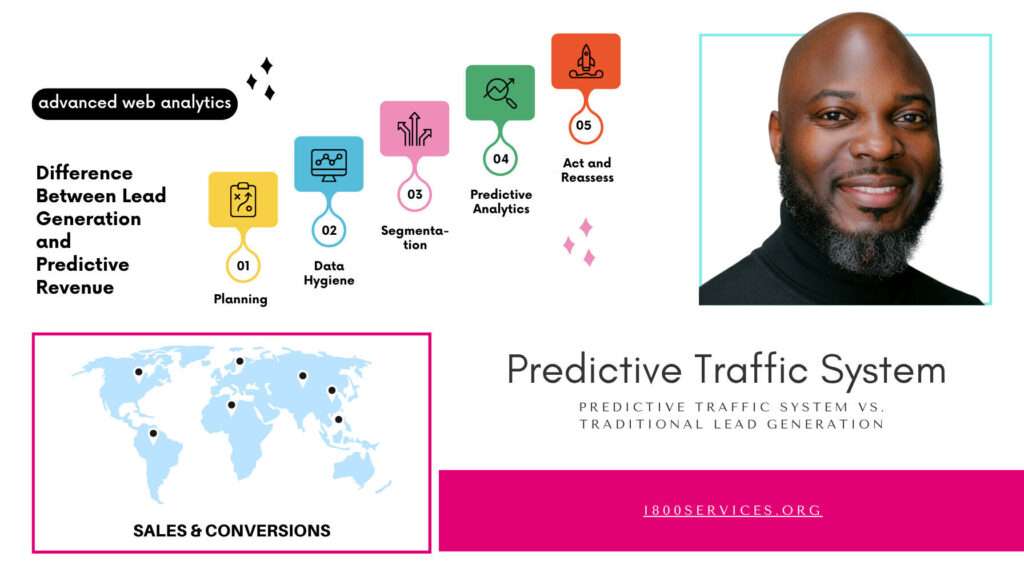The Difference Between Lead Generation and Predictive Revenue
The difference between lead generation and predictive revenue is scope and certainty. Lead generation attracts potential customers at the top of the funnel, while a predictive revenue system uses data, behavior signals, and analytics to forecast sales, prioritize high-intent buyers, and create consistent, scalable revenue across the entire customer journey.

💡 The Evolution Beyond Lead Generation
Traditional lead generation focuses on one thing: capturing contact information. You run ads, optimize forms, collect emails, and hope some percentage converts. It’s reactive, unpredictable, and increasingly expensive.
The fundamental problem? Lead generation treats every visitor the same and measures success in volume, not value.
A Predictive Revenue System operates on entirely different principles. Instead of chasing leads, you engineer conversions through behavioral intelligence, intent mapping, and systematic optimization across the entire customer journey.
Core Differences at a Glance
| Feature | Traditional Lead Generation | Predictive Revenue System |
| Goal | Capture as many contacts as possible | Generate predictable, measurable revenue |
| Measurement | Lead volume, cost per lead | Revenue per visitor, CLV, ROI |
| Approach | Single touchpoint (form, download) | 8-step conversion funnel (Discover → … → Forecast) |
| Predictability | Low (depends on luck and algorithms) | High (data-driven forecasting) |
| Revenue Connection | Indirect (leads → sales team → maybe revenue) | Direct (every action tracked to revenue outcome) |
Why Traditional Lead Generation Is Dying
After implementing systems for 500+ businesses, the pattern is clear:
Problem #1: Quality Over Quantity Illusion: Companies celebrate 1,000 leads, but often achieve a 0.2% conversion rate (2 closed deals). Volume doesn’t equal value.
Problem #2: No Intent Intelligence: Someone downloading your whitepaper could be a competitor, a student, or a ready-to-buy decision-maker. Traditional lead gen treats all five identically.
Problem #3: Algorithm Dependence: You’re playing a game where you don’t control the rules. Google changes the algorithm. Facebook increases ad costs. Your “proven strategy” stops working overnight.
How Predictive Revenue Systems Work
Instead of hoping leads convert, you engineer the conditions for conversion:
Intent-Based Traffic Acquisition: We map the customer journey through three intent stages: Informational, Commercial, and Transactional. You’re visible at research, consideration, and decision phases.
Behavioral Intelligence Tracking: Every visitor action creates a predictability score: Pricing page visits (buying intent), return visits, and feature comparison views. This is intelligence, not surveillance.
AI-Powered Lead Scoring: The system automatically assigns scores. A Hot Lead (60+ points) from an organic source, viewing the pricing page, triggers an immediate sales alert.
Revenue Forecasting: You can predict revenue before it happens. Example Calculation shows: $16,380 Projected monthly revenue from just one keyword, based on mathematics, not hope.
The Core Truth: As i800services founder Shola Emmanuel states: “Traffic alone doesn’t grow a business; systems do.” Your profit should be predictable, not dependent on algorithmic luck.
➡️ Next Step: The Outperformance Advantage
Understanding why predictive revenue systems consistently outperform lead generation requires examining the methodology and data. Continue to the Detailed Comparison Page

Systems Drive Success
WHAT WE'RE OFFERING: Access to the 7-Pillar System
© 2025 i800services
This website is not part of the YouTube, Google, or Facebook website; Google Inc or Facebook Inc.
Also, this website is NOT endorsed by YouTube, Google or Facebook in any way. FACEBOOK is a trademark of FACEBOOK Inc. YOUTUBE is a trademark of GOOGLE Inc.